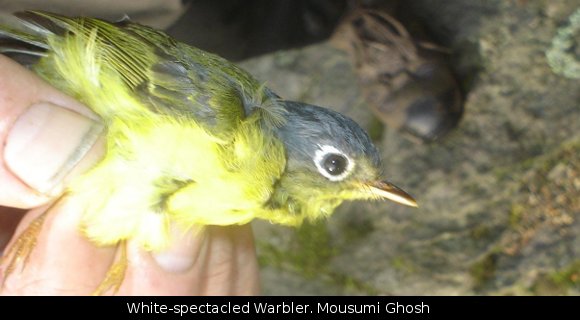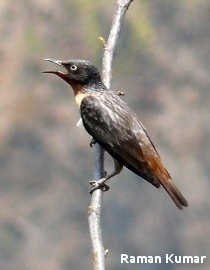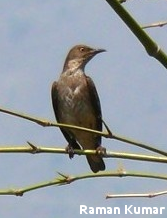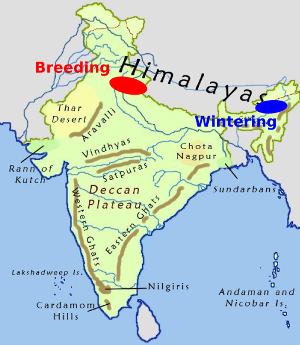By Mousumi Ghosh
Read Part I in this series of articles on leaf warblers
Wintering Season
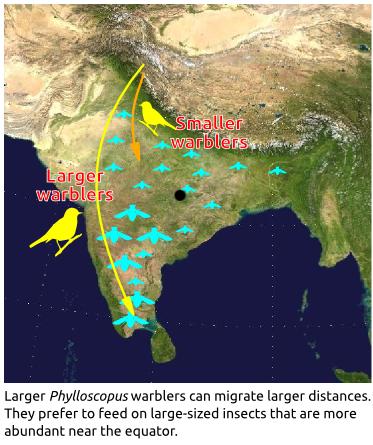 To most of us, Phylloscopus leaf warblers belong to just one size category: tiny! And confusing. Every winter, these diminutive and inconspicuous birds envelope the subcontinent in a wave, migrating thousands of kilometres south from their breeding grounds in the Himalayas and beyond. Migrating long distances takes a lot of energy, particularly for smaller species. Small differences in body weights among species make a huge difference in deciding how far they have to travel for wintering. Small-sized warblers are geared to feed on small insects, which are available in good quantities right from the Himalayan foothills all the way down south. The larger Phylloscopus warblers (like Large-billed, Greenish, and Western-crowned) do not have it so easy, as their preferred food – large insects – are available in adequate supply only further south. Hence, in the wintering season smaller species don’t travel very far, with their southern limit being either the sub-Himalayan foothills (e.g. Lemon-rumped Warbler) or mostly up to Central India (e.g. Hume’s Warbler), where wintering ranges of larger species begin. In contrast, larger species (e.g. Greenish and Western Crowned Warblers) travel farther south and all way to southern India and Sri Lanka.
To most of us, Phylloscopus leaf warblers belong to just one size category: tiny! And confusing. Every winter, these diminutive and inconspicuous birds envelope the subcontinent in a wave, migrating thousands of kilometres south from their breeding grounds in the Himalayas and beyond. Migrating long distances takes a lot of energy, particularly for smaller species. Small differences in body weights among species make a huge difference in deciding how far they have to travel for wintering. Small-sized warblers are geared to feed on small insects, which are available in good quantities right from the Himalayan foothills all the way down south. The larger Phylloscopus warblers (like Large-billed, Greenish, and Western-crowned) do not have it so easy, as their preferred food – large insects – are available in adequate supply only further south. Hence, in the wintering season smaller species don’t travel very far, with their southern limit being either the sub-Himalayan foothills (e.g. Lemon-rumped Warbler) or mostly up to Central India (e.g. Hume’s Warbler), where wintering ranges of larger species begin. In contrast, larger species (e.g. Greenish and Western Crowned Warblers) travel farther south and all way to southern India and Sri Lanka.
 A great deal of knowledge about the wintering ecology of Greenish Warblers has emerged from Madhusudan Katti’s work in the Kalakkad-Mundanthurai forests of Tamil Nadu. He found that individual birds, quite remarkably, come back to the same wintering territory year after year! Also, in years of scanty rainfall and limited food the birds were unable to eat enough to moult in time for their long journey back to their breeding sites. This shows how conditions in their wintering habitats may influence whether birds are able to make it back to breed; and this has obvious implications for the size of the population.
A great deal of knowledge about the wintering ecology of Greenish Warblers has emerged from Madhusudan Katti’s work in the Kalakkad-Mundanthurai forests of Tamil Nadu. He found that individual birds, quite remarkably, come back to the same wintering territory year after year! Also, in years of scanty rainfall and limited food the birds were unable to eat enough to moult in time for their long journey back to their breeding sites. This shows how conditions in their wintering habitats may influence whether birds are able to make it back to breed; and this has obvious implications for the size of the population.
Several parallels exist between the way these birds breed and winter. For example, the species which breed on “top of the mountains” (Hume’s and Greenish Warblers) spend the winter on “top of the trees”. Interestingly, while these two species are territorial in winter (both males and females defend territories), others, like the Western-crowned and Lemon-rumped Warblers, join mixed-species flocks. Although most species spend their breeding and wintering seasons in drastically different forests, they use similar foraging techniques. For instance, the Lemon-rumped Warbler (which breeds in conifer-mixed forests and winters in sal forests), mostly captures prey by hovering in the outer foliage of trees in both seasons.
Breeding Season
The Himalayas, because they provide such a huge variety of habitats, harbour one of the richest communities of leaf warbler species in the world. Twenty-one out of the world’s 61 species of Phylloscopus are found in the Himalayan region. They occupy the entire range of habitats from tropical evergreen/deciduous forests in the foothills to the alpine meadows above the treeline. In the Himalayas the elevation zone 2500–3000 m supports the highest diversity of breeding warblers, where up to 9 species may breed together.
How do so many similar species coexist in one place? One reason is that while superficially leaf warblers are very similar, different species possess differently sized body parts. This is associated with differences in foraging behaviour. For instance, larger species eat larger insects and species with wider beaks catch more flying insects. Another way to allow coexistence is by occupying different elevation zones. To avoid competing for similar food using similar methods, each altitudinal zone in the mountain typically has one large species, a medium species and a small species, which capitalize on prey in accordance to their body sizes.
 The overall drab colours of leaf warblers conceal subtle differences which not only indicate the habitat that they breed in, but also help in communicating and selecting mates. To the trained eye, visually distinguishing most of the leaf warblers involves relying on presence, number and colour of brighter patches such as wing bars, supercilium, rump patch and crown stripes. Species occurring in dense habitats, such as the Lemon-rumped Warbler, typically possess many bright patches (two wing bars, a distinct supercilium, crown stripe and rump patch). Such warblers often flash these patches to communicate. Additionally, males with brighter and longer wing bars are of higher quality (such males occupy larger territories) and are preferred by females. On the other hand, the Tickell’s Warbler, which breeds in open Juniper scrub, has no bright patches at all.
The overall drab colours of leaf warblers conceal subtle differences which not only indicate the habitat that they breed in, but also help in communicating and selecting mates. To the trained eye, visually distinguishing most of the leaf warblers involves relying on presence, number and colour of brighter patches such as wing bars, supercilium, rump patch and crown stripes. Species occurring in dense habitats, such as the Lemon-rumped Warbler, typically possess many bright patches (two wing bars, a distinct supercilium, crown stripe and rump patch). Such warblers often flash these patches to communicate. Additionally, males with brighter and longer wing bars are of higher quality (such males occupy larger territories) and are preferred by females. On the other hand, the Tickell’s Warbler, which breeds in open Juniper scrub, has no bright patches at all.
To be continued…Coming up next in this series: Tips for Identification of Phylloscopus Warblers

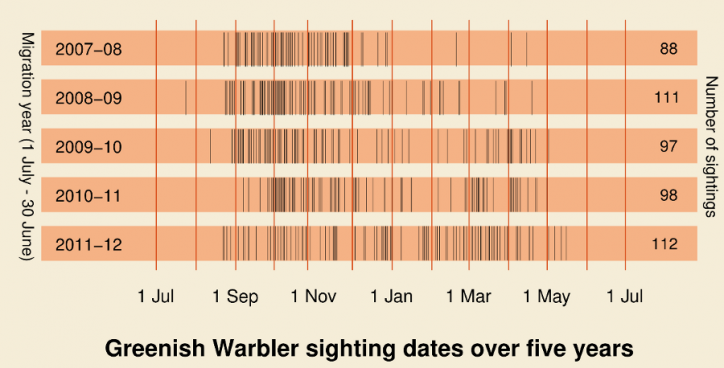
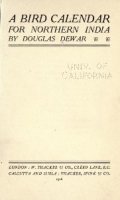
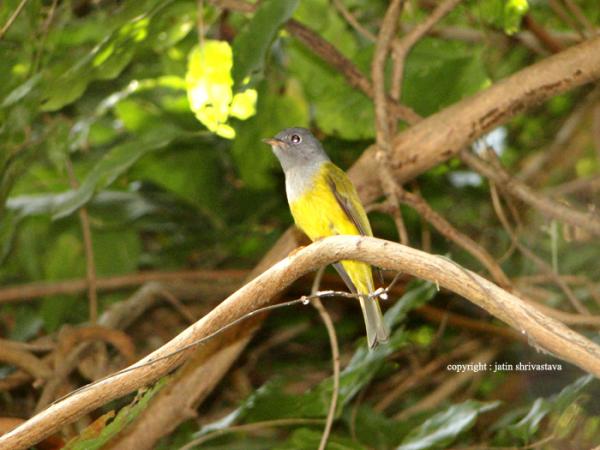



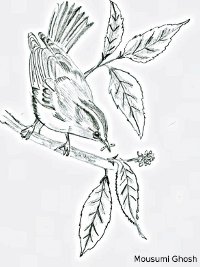 conveniently ignored every warbler I saw
conveniently ignored every warbler I saw